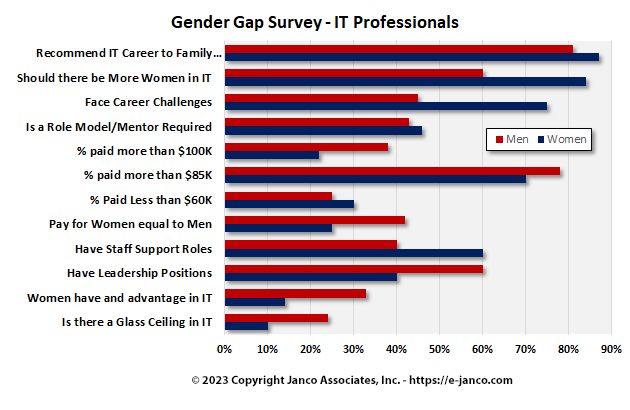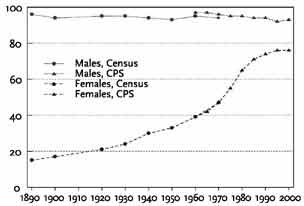Gender Gap Persists in IT



Newsletter Topics
- Hiring the Right Staff
- Gender Gap Persists in IT
- Interviewing Best Practices
Hiring the Right Staff - Best Practices
2011 Edition of Job Descriptions Released - 2011 Salary Data Available
The recession has been a big challenge for HR departments, as key IT professionals worry about working with reduced staff and tenuous job security. But amid that urgent pressure,CIO and IT managers need to make sure their HR strategy is looking long term as well, and to make sure HR, IT, and business unit leaders are driving change together.
It's a good time for CIO and IT managers to pressure HR to have a bigger impact. There's an expanding tool set today for doing interactive performance tracking and getting deeper insight into your company's talent pool, while also wringing more efficiency out of automation. HR and IT teams working together should be able to get results.
Building the IT Staff your company needs to succeed requires offering the right jobs at the right salary levels. Only the IT Hiring Resource Kit provides the industry-standard job descriptions and up-to-date salary data you need to recruit top talent as effectively and efficiently as possible. The salary survey includes a list of the benefits provided by enterprises of all size. Is your company providing the right benefits.
This indispensable resource provides up-to-date salary data gathered through an extensive survey of businesses throughout the United States and Canada, plus polished job descriptions for the 73 IT positions surveyed. This proprietary information will reduce the time it takes to recruit top talent and ensure that you get the right person for each job.
Gender Gap Persists in IT
Recent studies show that women still have few opportunities and are paid less for those that they get
The term gender gap usually refers to the systematic differences in the outcomes that men and women achieve in the labor market. These differences are seen in the percentages of men and women in the labor force, the types of occupations they choose, and their relative incomes or hourly wages. These economic gender gaps, which were salient issues during the women’s movement in the 1960s and 1970s, have been of interest to economists at least since the 1890s.
According to several major studies, including one by Janco Associates, Inc., there is a gender gap in a number of IT functions.Looking back at historical data we can see the importance women in the work place and why the gender gap is such a major issue.
Sources: 1890-1970, U.S. Bureau of the Census, Historical Statistics of the United States, Colonial Times to 1970 (Washington, D.C.: U.S. Government Printing Office, 1975); and 1960 to 2000, Current Population Survey (CPS). Overlap period shows differences in the measurement of the labor force in the U.S. decennial population census and the CPS.
The gender gap that gets the most attention is in earnings. The ratio of female earnings to male earnings in full-time, year-round positions has increased greatly since the 1980s. That is, women’s earnings rose from, on average, about 60 percent of what men made to about 75 percent. Although no comprehensive data exist for the period before about 1950, evidence for major sectors of the economy, when properly combined, suggests that the gender gap in earnings narrowed substantially during two earlier periods in U.S. history. Between about 1820 and 1850, an era known as the industrial revolution in America, the ratio of female-to-male full-time earnings rose from about 0.3, its level in the agricultural economy, to about 0.5 in manufacturing. From about 1890 to 1930, when the clerical and sales sectors began their ascendancy, the ratio of female earnings to male earnings again rose, from 0.46 to 0.56. But in neither of these periods did married and adult women’s employment expand greatly. Yet, between 1950 and 1980, when so many married women were entering the labor force, the ratio of female earnings to male earnings for full-time, year-round employees was virtually constant, at 60 percent.
What accounts for the difference in earnings between men and women? According to the literature, observable factors that affect pay—such as education, job experience, hours of work, and so on—explain no more than 50 percent of the wage gap. The most recent studies, as reported in a review by economists Blau and Kahn (2000), found that the fraction explained is now even lower, about 33 percent. The reason is that the decrease in the gender gap in earnings was largely due to an increase in the productive attributes of women relative to men. The remainder of the gap—termed the residual—is the part that cannot be explained by observable factors. This residual could result from workers’ choices or, alternatively, from economic discrimination. Surprisingly, the differing occupations of men and women explain only 10–33 percent of the difference in male and female earnings. The rest is due to differences within occupations, and part of that is due to the observable factors. In just about any year chosen, the ratio of women’s to men’s earnings decreases with age and rises with education. Most telling is that the ratio is higher for single than for married individuals, particularly for those without children. Family responsibilities have been an important factor in slowing women’s occupational advancement over the life cycle.
Interviewing Best Practices
Hiring is the most critical aspect of a CIO's role. For a CIO it can be fatal of they hire a new employee find out there is a mismatch.
Background screening is a critical part of the hiring process for the majority of organizations today, but it is even more essential in the current economy for several reasons. eJobDescription.com has found that a shortage of key skills is the number one challenge facing CIOs and IT functions. This may seem counter-intuitive at first given the news of continued high levels of unemployment and a "jobless" economic recovery. However coupled with many interviews with CIOs and HR professionals in end-user organizations, confirms that finding the right talent - the talent with the right mix of skills, behaviors and values to fit with the organization - is still a challenge. In fact, more applicants in the pool makes filtering and screening even more critical to ensure that time isn't wasted on candidates who aren't a good fit or who might not be qualified for the position.
Hiring managers understand that an interviewee's capability does not necessarily equal that they are a good fit. Capability refers to the skills, tools and experience that a person needs to successfully perform a job. It is no secret that most candidates exaggerate their abilities on their resumes and job applications. Things to look for are:
- Skills Definition - Good Job Descriptions - Do you know what skills are needed to perform the job and whether the employee possesses those skills? If they do not possess the necessary skills, how will the CIO help them to acquire them, and how long do you expect that process to take? It is in everyone's best interest for the CIO to set appropriate expectations for the employee from the beginning. This is especially true if the job requires special technical capabilities.
- Tools Definition - Good IT Infrastructure - Even if an individual has the skills and experience to do the job, do they have the tools to deliver peak performance? For example, a highly skilled and experienced web designer cannot build a website without adequate computer hardware and software. The tools do not have to be the most up-to-date, but a system that crashes can be incredibly frustrating and unproductive, even to the best performer.
- Experience - Just because an employee has the skills to do a job does not mean that they has the experience to apply those skills in his specific position. This is especially true for recent graduates, outside hires from different industries and internal hires from different departments. While the required skills may be similar from one job to the next, differing applications and terminology may require that the new hire take time to learn the nuances of his new position.



